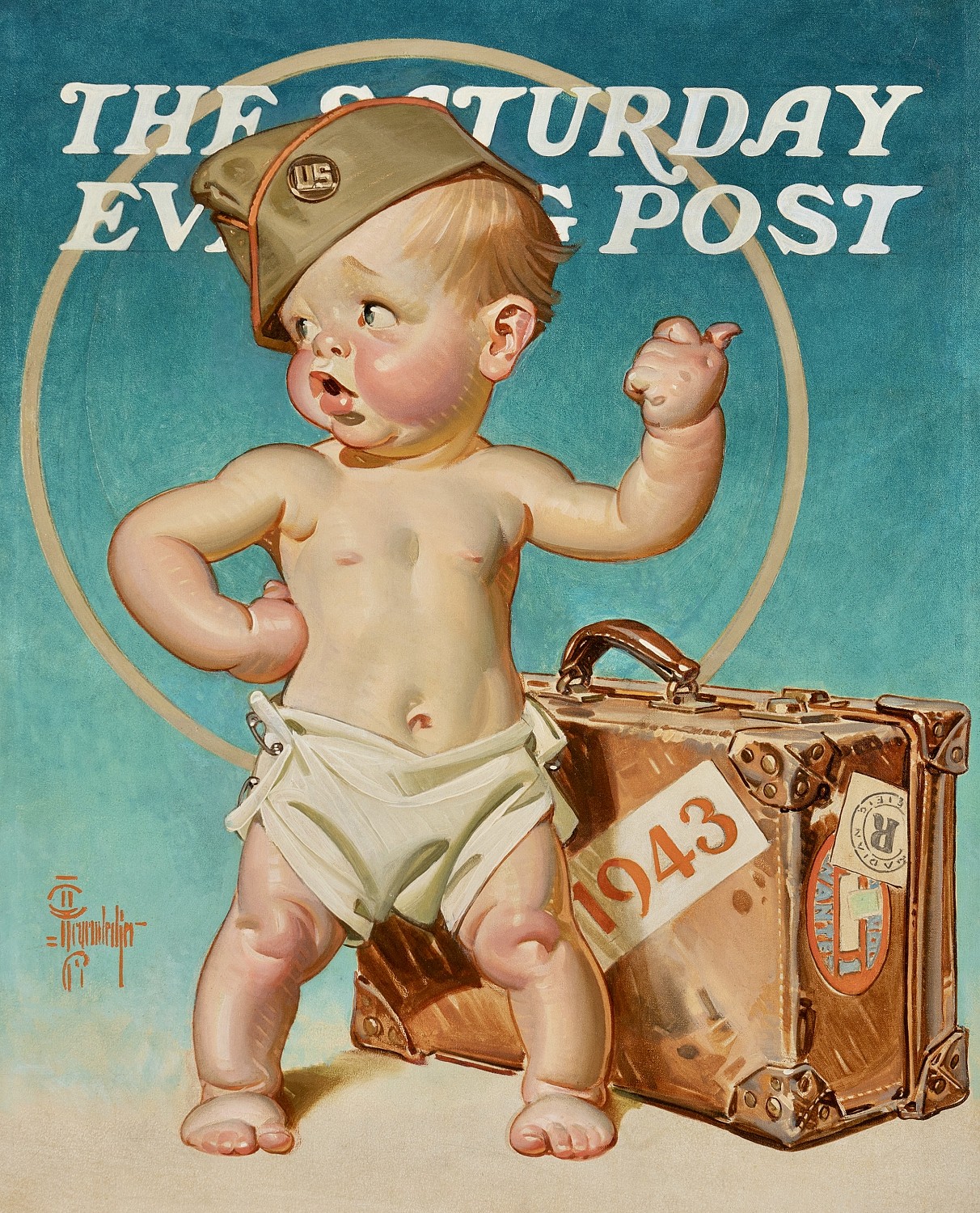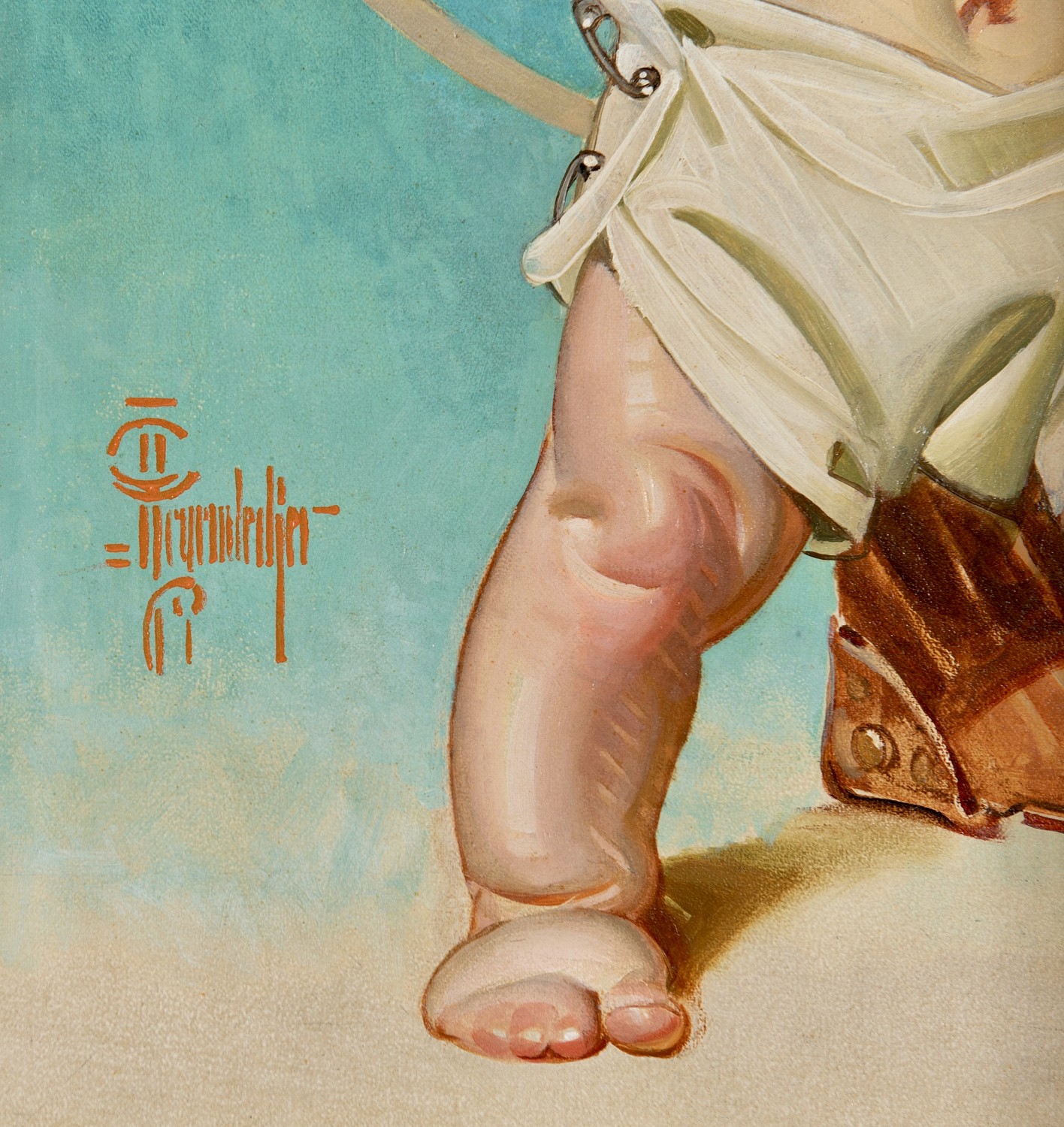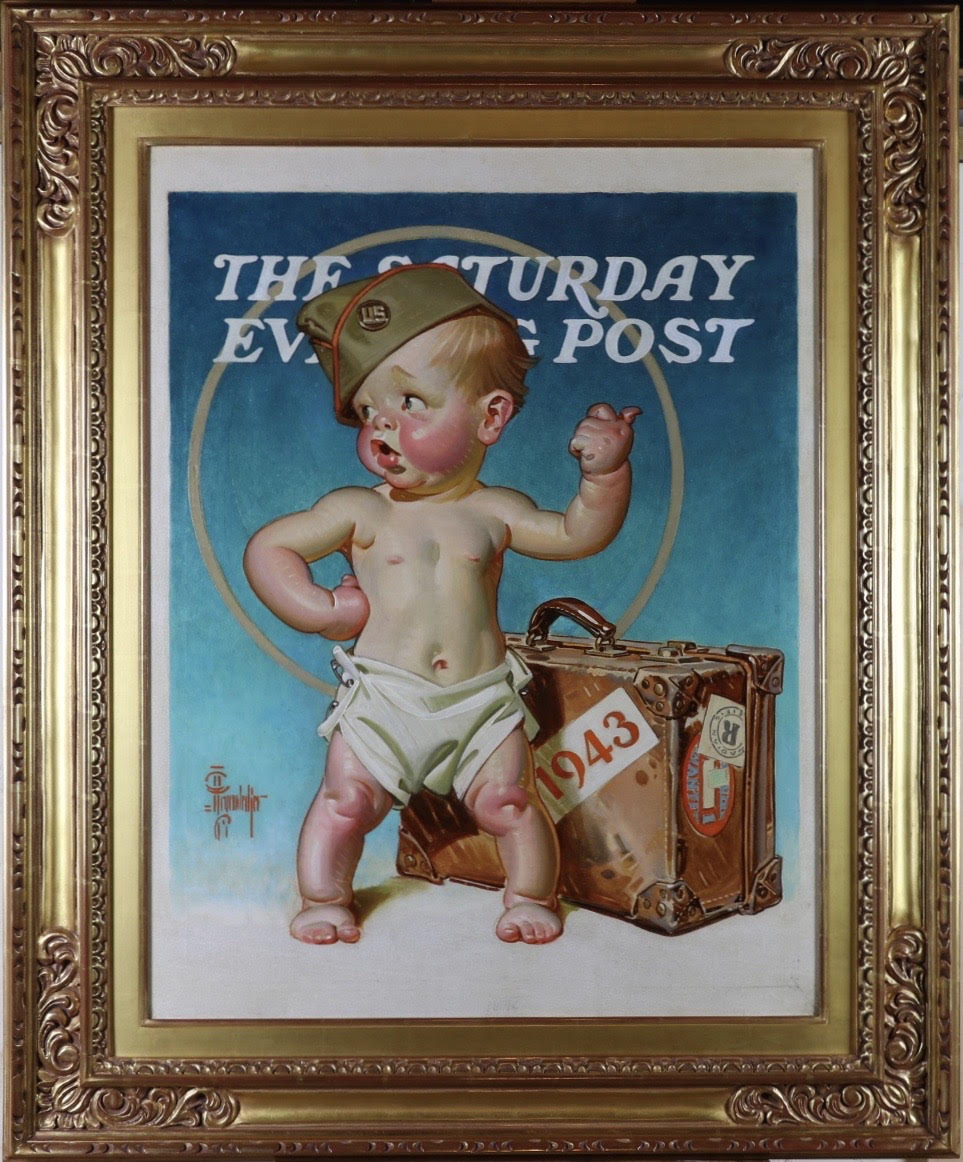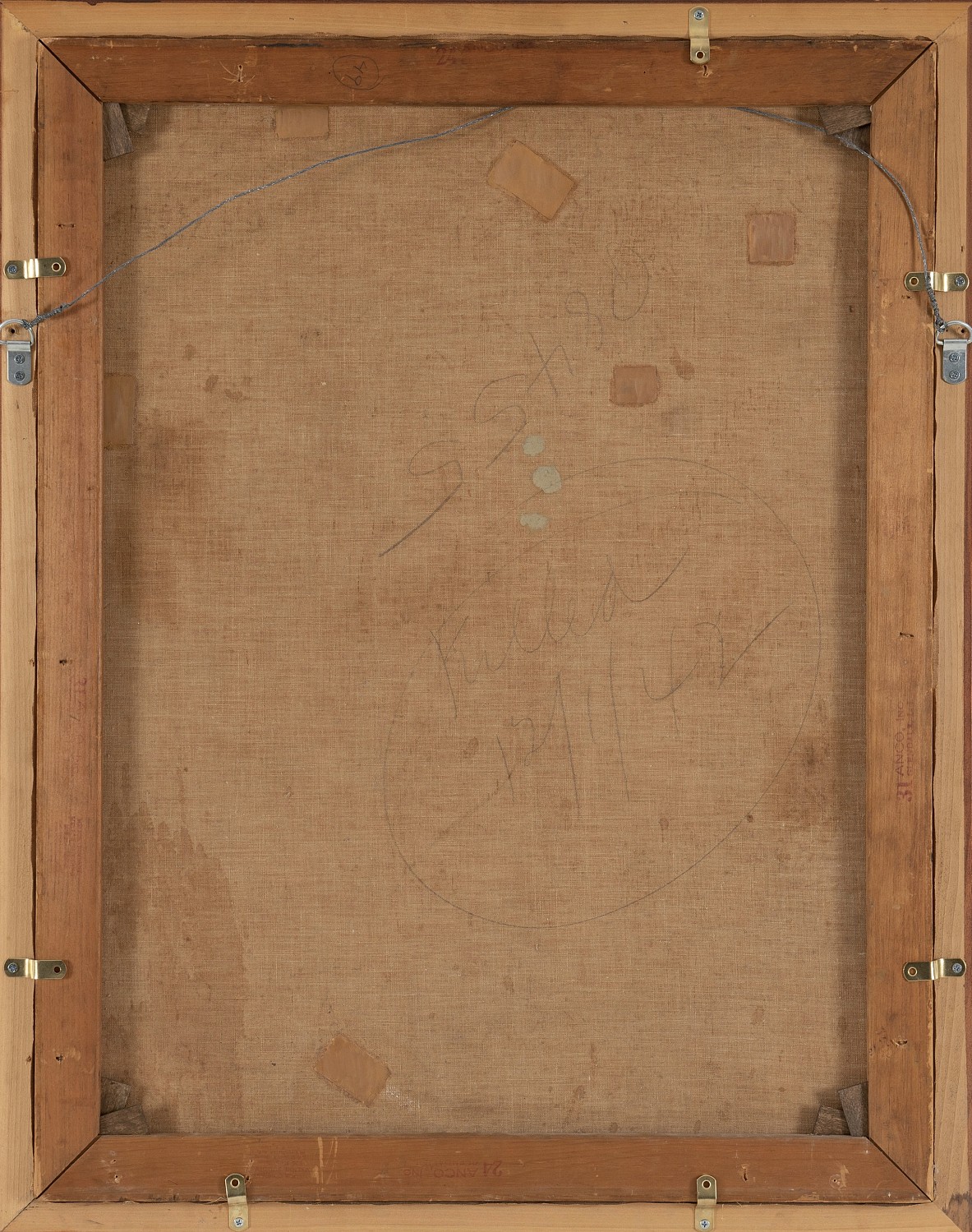"New Year's Baby Hitching to War" Lot no. 4136
By Joseph Christian Leyendecker (1874-1951)
1943
31.00" x 24.00"
Oil on Canvas
Signed Lower Left
REQUEST PRICE
PURCHASE REQUEST
The Saturday Evening Post unpublished cover, 1943
The story behind the New Year's Baby Hitching to War is a fascinating one: The painting was created by Leyendecker to be used as his final iconic New Year's Baby, and his last Saturday Evening Post cover altogether. However, when the Curtis publishing team reviewed the cover, they were concerned it was too unsympathetic to the mothers of America whose sons were headed off to war. Curtis requested that Leyendecker start again, demanding a clearer and more optimistic representation of American patriotism and victory.
On New Year's Day 1943. The state of war and its outcome were in doubt. The United States had lost ground in the Pacific, the Italian and Northern African fronts had brought few victories, and the Invasion of Normandy was over a year and half away. Leyendecker captures this feeling with the slightly befuddled and uncertain expression on the baby's face that is in direct contrast to his strong and puffed-up stance, as he attempts to hitch a ride to the battle front. The painting leaves the viewer relating to the baby's mixed emotions- he clearly feels a sense of duty, as evidenced by his strong stance-yet his confidence is betrayed by the look of fear and uncertainty in his eyes. It was likely this insecure, apprehensive expression that felt too close to home with Curtis publishing team. After all, this innocent, chubby-cheeked baby was an everyman, representing American's sons, brothers, fathers, and husbands headed to an uncertain fate in a war with no visible end.
In response to Curtis' request for a more assured and patriotic message, Leyendecker delivered New Year's Baby at War [1943], a dramatic work illustrating a rosy-cheeked cherub thrusting a bayonet clear through the German Swastika, set against a blood-red background (figure 1). However, with his final printed cover, Leyendecker achieved his intended message, with the baby's shocked and surprised lift of the eyebrows as a result of his violent action.
Despite being an unpublished cover, New Year's Baby Hitching to War perfectly encapsulates the meaning of Leyendecker's beloved New Year's Baby character. Debuting on the cover of the December 29, 1906 Saturday Evening Post, the cherubic baby graced various holiday covers, including Easter and the Fourth of July, but Curtis Publishing soon decided to use the baby exclusively as a New Year's symbol of America's major current issue, such as women's suffrage, Prohibition, entry into WW I, or economic recovery during the Depression. The New Year's Baby was the first cover every year for 37 years from 1906 to 1943. Indeed, the New Year's covers combined the approachable nature of a baby with the harsh realities of adult life prompting readers to consider their own role in current events and how to make the world a better place for children of the next generation.
The present work has never been seen until now, as it has resided with the family of Chairman of the Board and CEO E. Huber Ulrich of Curtis Publishing in the mid-1940s New Year's Baby Hitching to War offers discerning collectors the rare opportunity to own a piece of American History as well as Leyendecker's secret, previously unknown masterwork for The Saturday Evening Post.
Explore related art collections: $100,000 & Above / Humor / Children / Saturday Evening Post Covers / New Year's
See all original artwork by Joseph Christian Leyendecker
ABOUT THE ARTIST
Joseph Christian Leyendecker was born in Montabaur, Germany, and came to America at the age of eight. Showing an early interest in painting, he got his first job at 16 in a Chicago engraving house on the strength of some larger pictures he had painted on kitchen oilcloth. In the evenings after work, he studied under Vanderpoel at the Chicago Art Institute, and saved for five years to be able to go to France and attend the Academie Julian in Paris.
Upon his return, as a thoroughly trained artist with immense technical facility, Leyendecker had no difficulty in obtaining top commissions for advertising illustrations and cover designs for the leading publications. His first Post cover was done in 1899, and he did well over 300 more during the next 40 years. Among the most famous of these was his annual New Years Baby series.
His advertising illustrations made his clients famous. The Arrow Collar Man was a byword for the debonair, handsome male, and women wrote thousands of love letters to him in care of Cluett Peabody & Company. His illustrations for Kuppenheimer Clothes were equally successful in promoting an image of suited elegance. He was elected to the Society of Illustrators Hall of Fame in 1977.A major retrospective exhibition of Leyendecker's work was mounted at the Norman Rockwell Museum in Stockbridge, Massachusetts, in 1997-98.
Joseph Christian Leyendecker was born in Montabaur, Germany, and came to America at the age of eight. Showing an early interest in painting, he got his first job at 16 in a Chicago engraving house on the strength of some larger pictures he had painted on kitchen oilcloth. In the evenings after work, he studied under Vanderpoel at the Chicago Art Institute, and saved for five years to be able to go to France and attend the Academie Julian in Paris.
Upon his return, as a thoroughly trained artist with immense technical facility, Leyendecker had no difficulty in obtaining top commissions for advertising illustrations and cover designs for the leading publications. His first Post cover was done in 1899, and he did well over 300 more during the next 40 years. Among the most famous of these was his annual New Years Baby series.
His advertising illustrations made his clients famous. The Arrow Collar Man was a byword for the debonair, handsome male, and women wrote thousands of love letters to him in care of Cluett Peabody & Company. His illustrations for Kuppenheimer Clothes were equally successful in promoting an image of suited elegance. He was elected to the Society of Illustrators Hall of Fame in 1977.A major retrospective exhibition of Leyendecker's work was mounted at the Norman Rockwell Museum in Stockbridge, Massachusetts, in 1997-98.
Kent Steine







